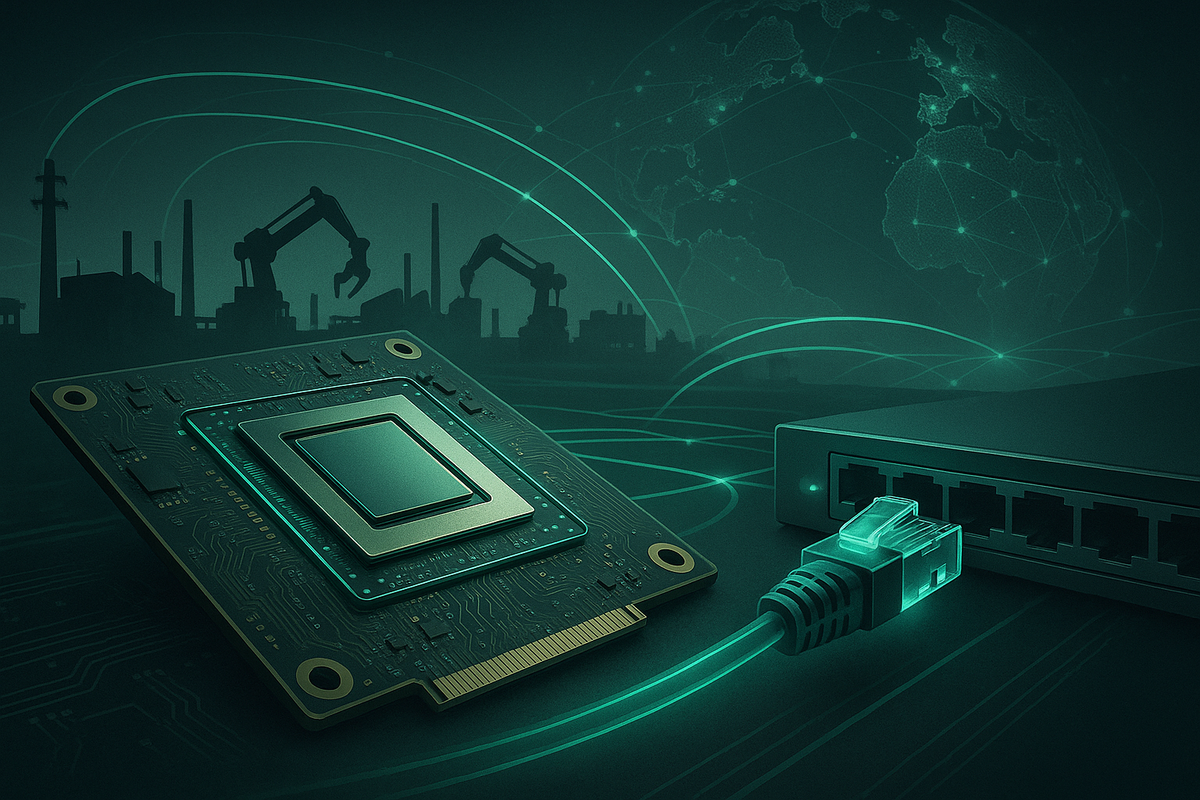Beyond GPUs: NVIDIA Forges New Frontiers in AI, Industrial Tech, and Global Connectivity

NVIDIA (NASDAQ: NVDA), a titan in the world of accelerated computing, has unveiled a series of groundbreaking announcements that signal a strategic evolution far beyond its traditional dominance in graphics processing units. The company's recent disclosures, including new RTX PRO Blackwell GPUs, an expanded, high-stakes partnership with industrial giant Siemens (ETR: SIE), and the introduction of its pioneering Spectrum-XGS Ethernet, collectively underscore a robust diversification strategy aimed at embedding NVIDIA's AI and accelerated computing platforms into the very fabric of future industries. These moves are not merely incremental upgrades; they represent a concerted effort to architect the foundational infrastructure for the next generation of AI, intelligent manufacturing, and distributed supercomputing, with profound implications for the global financial markets and technological landscape.
The immediate implications are clear: NVIDIA is doubling down on its full-stack approach, extending its influence from the silicon level to comprehensive software and networking solutions. This strategy is designed to create an unparalleled ecosystem that will be challenging for competitors to replicate, further cementing NVIDIA's pivotal role in the ongoing AI revolution and opening vast new revenue streams in enterprise, industrial, and hyperscale cloud markets.
NVIDIA's Bold Strides: New GPUs, Siemens Alliance, and Giga-Scale Ethernet Reshape the Landscape
NVIDIA's recent flurry of announcements, notably revealed around SIGGRAPH 2025 (August 11-13, 2025) and other key industry events, mark a significant pivot in its market strategy. These developments are centered on three core pillars: enhancing professional graphics, revolutionizing industrial digitalization, and enabling geographically distributed AI supercomputing.
Firstly, NVIDIA introduced new professional graphics cards: the RTX PRO 4000 SFF Edition and the RTX PRO 2000 Blackwell. These GPUs, based on the advanced Blackwell architecture, are tailored for small-form-factor (SFF) workstations and are designed to power professionals in engineering, design, content creation, and AI at the edge. The RTX PRO 4000 Blackwell SFF Edition boasts 24GB of GDDR7 memory with ECC support and 8,960 CUDA cores, delivering up to 770 AI TOPS. It promises up to 2.5 times higher AI performance and 1.7 times faster ray-tracing than its predecessor, the RTX A4000 SFF. Similarly, the RTX PRO 2000 Blackwell, with 16GB of ECC GDDR7 memory and 4,352 CUDA cores, offers 545 AI TOPS and significant speed improvements across 3D modeling, CAD, and AI-driven content generation. These compact, energy-efficient powerhouses are set to be available later in 2025 through partners like PNY and TD SYNNEX, and integrated into workstations from Dell (NYSE: DELL), HP (NYSE: HPQ), and Lenovo.
Secondly, a monumental expansion of NVIDIA's partnership with industrial automation powerhouse Siemens (ETR: SIE) was announced around June 11, 2025. Building on their 2022 collaboration, this alliance aims to accelerate industrial AI and digitalization, fundamentally shaping the "factory of the future." Key initiatives include merging NVIDIA's AI and accelerated computing with Siemens' Xcelerator platform to drive next-generation factory automation, from design to execution. Siemens is launching a new line of Industrial PCs, certified for NVIDIA GPUs, designed for harsh factory environments and capable of a 25x acceleration in AI execution. Furthermore, the Siemens Industrial Copilot, powered by NVIDIA NeMo microservices and NVIDIA AI Blueprint, is being developed to offer real-time, AI-driven assistance for shopfloor operations, with projections of saving 30% in reactive maintenance time. This partnership also extends to pioneering AI-driven operational technology (OT) cybersecurity using NVIDIA BlueField Data Processing Units (DPUs) and advancing the "industrial metaverse" through full-fidelity digital twins and real-time AI, exemplified by BMW Group's (ETR: BMW) 30x speedup in vehicle aerodynamics simulations using NVIDIA Blackwell GPUs and Siemens' Simcenter Star-CCM+ software.
Finally, NVIDIA unveiled the Spectrum-XGS Ethernet around August 22-26, 2025, a "scale-across" technology designed to interconnect distributed data centers into unified, giga-scale AI super-factories. This innovation addresses the growing challenge of individual data centers reaching their power and capacity limits, enabling AI infrastructure to scale beyond single physical locations. Spectrum-XGS Ethernet integrates advanced algorithms for distance-aware congestion control, precision latency management, and end-to-end telemetry. NVIDIA claims it can nearly double the performance of its Collective Communications Library (NCCL) for GPU-to-GPU communications across long distances. Hyperscalers like CoreWeave are among the first to adopt this technology, integrating Spectrum-XGS to unify their distributed AI data centers into a single supercomputing fabric, particularly for cloud AI deployments where cost-effectiveness and geographic distribution are paramount.
NVIDIA and Siemens Emerge as Clear Winners, Competitors Face Intensified Pressure
NVIDIA's recent strategic maneuvers are poised to create significant beneficiaries while intensifying competitive pressures on others across the technology and industrial landscapes.
NVIDIA (NASDAQ: NVDA) itself is the undeniable primary winner. The new RTX PRO Blackwell GPUs solidify its leadership in professional visualization, AI development, and simulation, targeting high-value workloads. The enhanced performance, particularly for AI inference and ray tracing, extends its technological lead against rivals like Advanced Micro Devices (NASDAQ: AMD) and Intel (NASDAQ: INTC). The expanded Siemens partnership is a long-term strategic triumph, deeply embedding NVIDIA's AI and accelerated computing platforms into the colossal industrial automation sector. This opens substantial new revenue streams for NVIDIA's GPUs, DPUs, and software (Omniverse, AI tools) within manufacturing, design, and OT cybersecurity, moving its influence into critical sectors beyond pure computing hardware. Furthermore, Spectrum-XGS Ethernet fortifies NVIDIA's position as a holistic AI infrastructure provider. By enabling geographically dispersed data centers to function as one unified AI factory, NVIDIA ensures its GPUs operate at peak efficiency in distributed environments, potentially leading to increased sales of its Spectrum-X switches and ConnectX-8 SuperNICs alongside its core GPU offerings.
Siemens (ETR: SIE) is another substantial winner from the deepened partnership. By integrating NVIDIA's cutting-edge AI and accelerated computing capabilities into its Xcelerator platform, Siemens can offer vastly improved solutions in industrial automation, digital twin technology, generative AI for design, and factory operations. The demonstrable performance gains, such as the 30x speedup in simulations for BMW Group and the projected 30% reduction in reactive maintenance time with the Industrial Copilot, provide Siemens with significant competitive advantages. This collaboration positions Siemens at the forefront of industrial digitalization and smart manufacturing, offering its customers unparalleled tools for efficiency and innovation.
Conversely, other GPU manufacturers like Advanced Micro Devices (NASDAQ: AMD) and Intel (NASDAQ: INTC) face intensified pressure. NVIDIA's continuous advancements with the Blackwell architecture, coupled with its robust CUDA software ecosystem, raise the performance bar significantly, making it harder for AMD's Radeon Pro and Intel's Arc Pro lines to compete effectively in high-margin professional and AI markets. The deep integration with Siemens also limits opportunities for AMD and Intel to penetrate the industrial AI and automation markets with their own accelerator solutions.
In the networking equipment sector, companies such as Cisco (NASDAQ: CSCO) and Arista Networks (NYSE: ANET) might face a mixed impact, leaning towards a challenge. NVIDIA's Spectrum-XGS Ethernet directly competes with traditional networking providers in the burgeoning AI data center segment. Spectrum-XGS's specialized features for AI workloads, like distance-aware congestion control, offer benefits that standard Ethernet solutions may not easily provide, potentially leading NVIDIA to capture a larger share of the networking infrastructure within AI-centric data centers. While some integration opportunities may arise, these established players will need to rapidly innovate or adapt to offer comparable AI-optimized networking solutions.
Finally, other industrial automation companies like Rockwell Automation (NYSE: ROK) and ABB (SIX: ABBN) could find themselves under increased competitive pressure. The formidable alliance between Siemens and NVIDIA for "AI-powered factories of the future" sets a new benchmark for integrated IT/OT strategies. These companies will need to accelerate their own AI and digitalization efforts, either through internal development or by seeking similar strategic partnerships, to keep pace with the enhanced capabilities now offered by the Siemens-NVIDIA collaboration in areas like AI-powered digital twins, advanced simulations, and efficient industrial copilots.
Broad Industry Impact: Accelerating the AI-Driven Future
NVIDIA's recent strategic moves are not isolated incidents; they are integral to, and will significantly accelerate, several profound industry trends shaping the technological landscape. These announcements underscore a future where AI, digital twins, and distributed computing are not just buzzwords but foundational elements of global infrastructure.
Firstly, the Industrial AI and Digital Twin revolution receives a massive boost from the expanded Siemens partnership and the power of RTX PRO Blackwell GPUs. This collaboration is fundamentally shifting the industrial sector from traditional automation to AI-powered operations. By deeply integrating NVIDIA's AI and Omniverse capabilities with Siemens' Xcelerator platform, industries can now create more immersive, photorealistic, and physics-based digital twins, vastly improving product design, simulation, and manufacturing processes. Generative AI will accelerate workflows, enabling faster iteration and contextualization of engineering data. This convergence means factories can become "smart" in a truly unprecedented way, with AI copilots assisting human operators, predictive maintenance becoming the norm, and design cycles shrinking dramatically. The ripple effect here is immense, pushing other industrial software and automation providers to rapidly adopt similar AI-driven strategies or risk being left behind in the race for efficiency and innovation.
Secondly, Distributed Computing for Giga-Scale AI is becoming a reality with Spectrum-XGS Ethernet. As the computational demands for training trillion-parameter AI models outstrip the capabilities of single data centers, the ability to seamlessly connect geographically dispersed facilities into a unified AI super-factory is critical. Spectrum-XGS addresses this by optimizing GPU-to-GPU communication over long distances, effectively making a global network of data centers behave as a single, massive supercomputer. This innovation will catalyze the development of even larger and more complex AI models, pushing the boundaries of what AI can achieve. It also has significant implications for cloud service providers, enabling them to offer more flexible and resilient AI infrastructure, while potentially challenging traditional networking equipment providers who must now adapt to NVIDIA's specialized, AI-optimized solutions.
Historically, NVIDIA's current trajectory draws parallels to Intel's (NASDAQ: INTC) dominance in the PC era with its x86 CPU architecture, or Cisco's (NASDAQ: CSCO) foundational role in the internet infrastructure boom. Just as these companies became indispensable for their respective technological revolutions, NVIDIA, with its GPUs and the pervasive CUDA ecosystem, is cementing itself as the indispensable platform for AI development. This full-stack approach, encompassing hardware, software, and now networking for distributed AI, creates a powerful ecosystem lock-in that makes it incredibly challenging for competitors. However, this dominance also invites regulatory scrutiny. The U.S. Department of Justice (DOJ) is reportedly scrutinizing NVIDIA's market practices for potential antitrust violations, while export controls, particularly to China, continue to impact its global business strategy, forcing product modifications and market adaptations. These regulatory and geopolitical headwinds represent a key challenge that could temper NVIDIA's otherwise unbridled growth.
What Comes Next: A Future of AI Super-Factories and Industrial Metamorphosis
The strategic announcements from NVIDIA paint a vivid picture of what comes next, both in the short and long term, for the company and the industries it touches. These developments are set to accelerate the "AI everything" paradigm, driving further market opportunities while also demanding strategic pivots from various players.
In the short term, NVIDIA is poised to maintain its unparalleled growth trajectory, driven by the insatiable demand for its Blackwell GPUs. The immediate availability and integration of these new RTX PRO GPUs into professional workstations will empower designers, engineers, and AI developers with unprecedented computing power, accelerating projects and product cycles. The initial rollout of Siemens Industrial PCs and the Industrial Copilot will begin to demonstrate the tangible benefits of AI on factory floors, driving early adoption and deeper integration of NVIDIA's technology into core industrial processes. Spectrum-XGS Ethernet, with early adopters like CoreWeave, will immediately begin to unlock the potential of distributed AI super-factories, allowing for the training of larger, more complex AI models than ever before. NVIDIA's continued commitment to an annual release cadence for new architectures, such as the upcoming Rubin platform, ensures a relentless pace of innovation designed to stay ahead of the curve.
Looking at the long term, NVIDIA's diversification efforts are designed for sustained influence. The expanded Siemens partnership lays the groundwork for the widespread realization of the "industrial metaverse" – a full-fidelity digital twin of the physical world that revolutionizes manufacturing, supply chains, and operational management. This future will see AI not just assisting but autonomously managing and optimizing complex industrial systems, creating new markets for specialized AI software, services, and advanced robotics. Spectrum-XGS Ethernet will become a foundational component for a globally interconnected AI infrastructure, enabling AI training and inference at scales previously unimaginable, transcending geographical limitations. This "scale-across" capability will be critical as AI models continue to grow exponentially, requiring distributed computing resources spanning continents.
These developments will necessitate strategic pivots from competitors. Other GPU manufacturers, such as Advanced Micro Devices (NASDAQ: AMD) and Intel (NASDAQ: INTC), will need to accelerate their own roadmaps and bolster their software ecosystems to offer compelling alternatives. Networking providers like Cisco (NASDAQ: CSCO) and Arista Networks (NYSE: ANET) must innovate to offer AI-optimized interconnects or explore strategic partnerships to remain relevant in the hyperscale AI data center market. Industrial automation companies (e.g., Rockwell Automation (NYSE: ROK), ABB (SIX: ABBN)) will be compelled to integrate AI and digital twin capabilities deeply into their offerings, potentially seeking their own AI hardware and software partners to compete with the formidable Siemens-NVIDIA alliance. For hyperscalers (e.g., Microsoft (NASDAQ: MSFT), Amazon (NASDAQ: AMZN), Alphabet (NASDAQ: GOOGL)), while they remain key customers, the long-term trend of developing custom AI chips will continue, creating a multi-accelerator ecosystem that NVIDIA will need to navigate through continued innovation and strong ecosystem support.
Emerging market opportunities are vast, ranging from the industrial metaverse and giga-scale AI infrastructure to AI-powered cybersecurity in OT environments and advanced robotics. However, significant challenges loom, including intensified competition, potential supply chain constraints amidst "off-the-charts" demand, geopolitical tensions impacting market access (especially China), and the sheer cost and energy consumption associated with building and operating these massive AI systems. Regulatory scrutiny over NVIDIA's market dominance will also likely increase.
Conclusion: NVIDIA's AI Ascendancy and the Redefinition of Technology
NVIDIA's recent announcements represent more than just product launches; they are strategic declarations that firmly position the company as the foundational architect of the global AI revolution. By unveiling new RTX PRO Blackwell GPUs, deepening its transformative partnership with Siemens, and introducing the innovative Spectrum-XGS Ethernet, NVIDIA is not merely diversifying its portfolio; it is meticulously weaving its AI and accelerated computing platforms into the core fabric of professional visualization, industrial digitalization, and distributed supercomputing.
The key takeaways are clear: NVIDIA's full-stack approach, encompassing cutting-edge hardware, the ubiquitous CUDA software ecosystem, and now advanced networking for scalable AI, creates a formidable and increasingly indispensable platform. This strategy allows the company to capture value across multiple layers of the AI value chain, from chip design to industrial software and global data center infrastructure. The alliance with Siemens, in particular, signals a powerful move into the vast and largely untapped market of industrial AI and digital twins, promising to reshape manufacturing and operational technologies. Spectrum-XGS Ethernet, meanwhile, addresses a critical bottleneck for hyperscale AI, enabling a future of interconnected "giga-scale AI super-factories."
Moving forward, the market will undoubtedly be defined by escalating AI development and deployment. NVIDIA's relentless pace of innovation, including its commitment to an annual product cadence, aims to maintain its technological lead. However, this future will also be characterized by intensifying competition from rivals like Advanced Micro Devices (NASDAQ: AMD) and Intel (NASDAQ: INTC), as well as the growing trend of hyperscalers developing their own custom AI silicon. Geopolitical factors, particularly U.S.-China trade relations and export controls, will continue to cast a shadow, influencing market access and supply chain strategies. Furthermore, NVIDIA's increasing market dominance will likely attract sustained antitrust scrutiny.
For investors, NVIDIA (NASDAQ: NVDA) presents both significant opportunities and inherent risks. The company's unrivaled leadership in the rapidly expanding AI sector, coupled with its strategic diversification into high-growth areas like automotive AI and industrial digital twins, offers substantial long-term growth potential and robust profitability. Its long-term vision for "Agentic AI" and "Physical AI" points to continued innovation defining the next waves of computing. However, investors must closely monitor the evolving competitive landscape, any further geopolitical developments impacting key markets, and the potential for increased regulatory oversight. While the valuation is high, the sustained demand for AI infrastructure and NVIDIA's pivotal role in enabling it suggest continued strength.
In the coming months, investors should watch for NVIDIA's future earnings reports, especially the performance of its data center segment and any updates on capital allocation. Developments in the China market, competitive responses from rivals, and the market reception of new architectures like Rubin will be crucial indicators. Ultimately, NVIDIA's strategic moves are not just about incremental gains; they are about fundamentally redefining the technological landscape, setting the stage for an AI-powered future where its influence extends into every corner of the digital and physical worlds.



